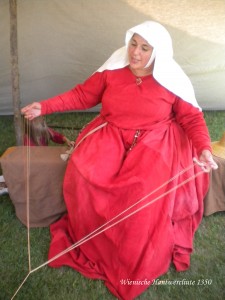Fingerlooping
Fingerlooping was a well known technique in medieval times, especially late medieval. The product, strings from silk, wool or linnen yarn was very durable and therefor ideal for tieing clothing together (trousers to their belt, dresses, cotehardies) or for the use in all kinds of textile accessories like f.e. drawstring-pouches.
The crafter works with loops of string which (as in braiding) are intertwined and braided into each other and then knotted on both ends. A minimum of 5 loops is needed, the more simple braids are worked with an uneven number of loops, more difficult braids also with even numbers. Some depictions show 2 persons working on one string by sitting behind each other and working with 4 hands.
The loops are distributed on the fingers and the pattern is being created through a steady rhythm of repeating exchanges.
Some very skilled loopers can even braid patterns like letters into the braids.






